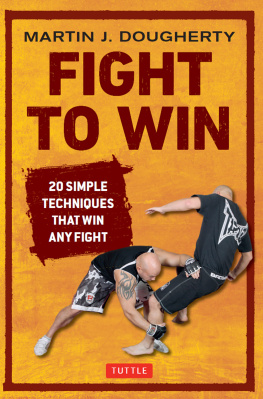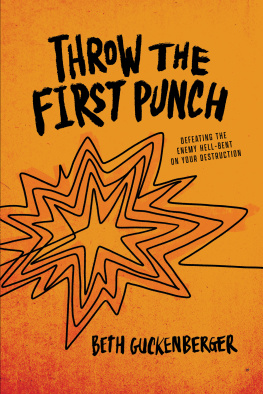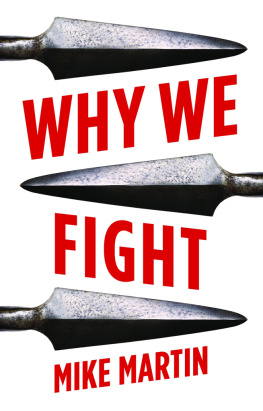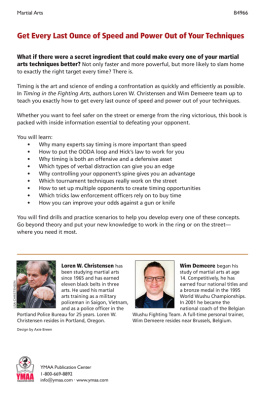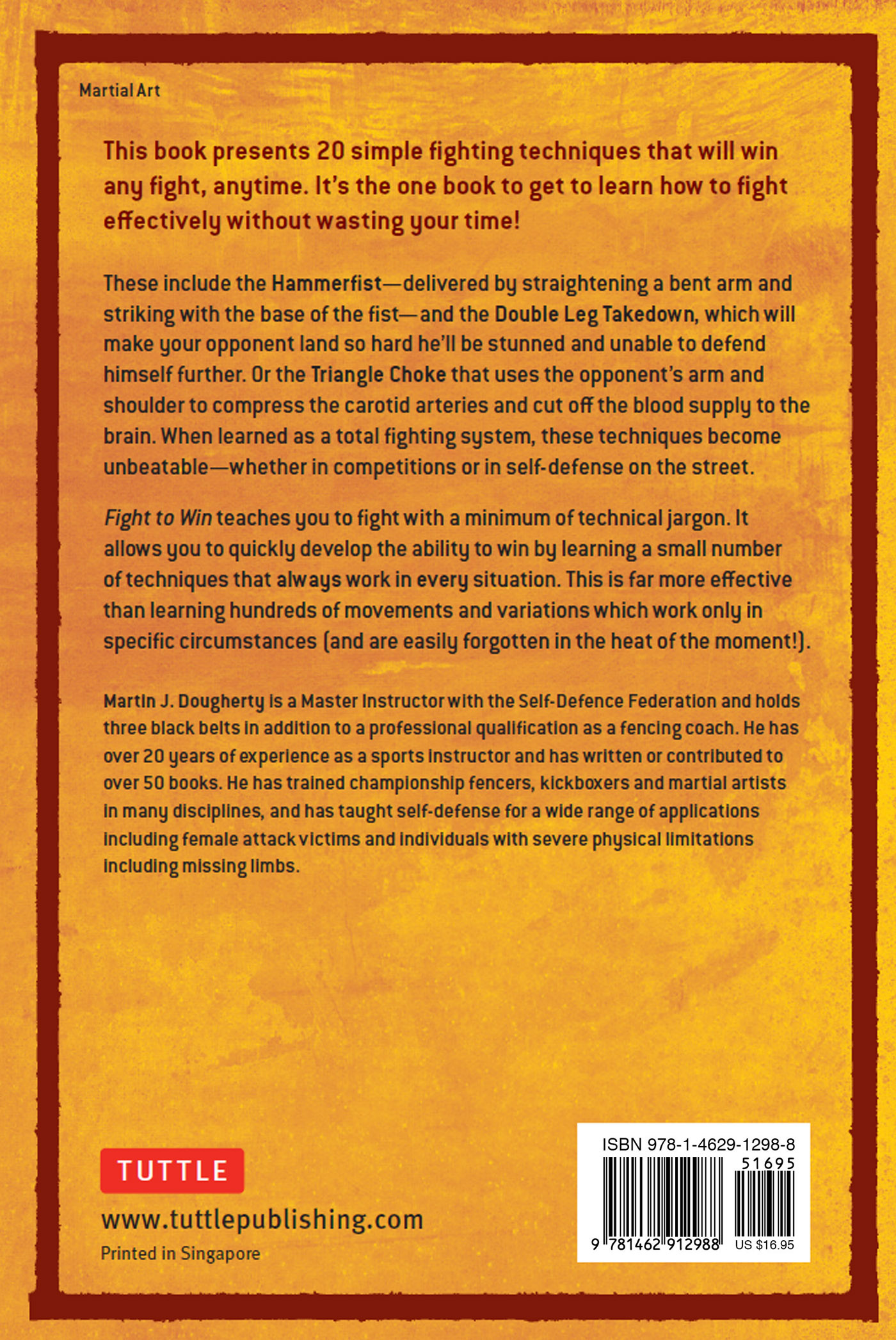Thanks are due to many people who assisted in various ways: Rick Burns and the members of Burns School of Black Belts for their assistance and the use of their venue.
Chris Wilson and the members of SDF Peterlee, for their assistance.
The many people who have taught me, but most notably Dave Turton.
Gavin Lanata and Paul Green for being accommodating about camera stuff.
Nate Zettle for so many things that itd take the rest of the book to catalog them.
CHAPTER 1
Martial Artist or Fighter?
Martial Arts and Personal Combat
The term martial art can be defined as fighting system, or perhaps military (or warrior) skills. All martial arts have their origins in personal combat, often in a military context. However, over time the focus has drifted, and today the various activities that come under the heading of martial arts are quite varied. Not all martial arts have fighting as their focus, and some really have nothing to do with combat any more.
Some arts are geared more towards fitness, sport, personal development, the preservation of traditional systems, and all kinds of other goals. This does not make any of them intrinsically good or bad. If an art does what it is supposed tolike looking amazing on demonstrations, or instilling confidence and self-discipline in childrenand does it well, then it is by definition good for its stated purpose and a worthy endeavor in its own right.
For our purposes, though, we are mostly interested in combat effectiveness and it is fair to say that some arts are more useful for personal combat than others. However, even the best fighting system has weak areas and blind spots. Finding them and plugging the gaps is the primary reason for a system to evolve over time. Early Mixed Martial Arts competitions demonstrated the need to be an all-around fighter. A combatant who can exploit the gaps in his opponents capabilities can win an easy victory, so it is logical to develop the capability to deal with all of the likely threats. Equally, some capabilities are not necessary to some martial arts due to their competition rules.

The axe kick looks awesome but its very hard to land one in a serious fight. The time spent learning to perform such difficult techniques is better spent on bread-and-butter skills.
It is important to view any given martial art in this light. For example, a striking art that does not allow any form of grappling or punches to the head in its competitions has obvious weak areas when outside these artificial constraints. It is optimized for a particular style of combat and is strong there. For example, ju-jitsu and judo contain many of the same throws and takedowns, but a ju-jitsu practitioner is expected to also learn striking and many submissions that are not contained in the judo body of technique. Which is better? That depends entirely on what you want to do with it. If your aim is to do well in judo competition, then you would be well advised to train in judo. For more general applications, ju-jitsu is more flexible.
A given martial art is not bad or useless if it does not cover one or another aspect of personal combat, but it may not be a good choice if all-round capability is your goal. Many highly focused arts contain excellent techniques within their own arena but are weak elsewhere. The only time this is a problem is when an instructor of one of those arts discounts a threat his students are ill-equipped to deal with effectively.

There is little point in training to fight from the clinch in a sport where the fighters are quickly separated, such as boxing. Clinch work is vital for more general applications, not least as a transition stage between standup and your ground game.
So it is perfectly fine to say something like, were teaching non-contact karate. Its excellent for fitness, self-discipline and we clean up in non-contact point fighting competitions if thats true. The same instructor claiming Were teaching non-contact karate, the ultimate fighting system ever. Grapplers? Pah, you just kick them right off the planet before they can grab you! may actually not realize that what he is saying is untrue, but nevertheless it is a misleading claim.
It is necessary to be realistic about martial arts when seeking somewhere to train. A good art does what it is supposed to, whatever that may be. Good does not always equate to ideal for personal combat though. It is worth looking at a few different classes before committing to something. However, just because an art is not the ultimate all-round fighting system does not mean you should pass it up. If you enjoy it and get something out of it, then its a good place to train. There is nothing to stop you going to a class for fun and working on fight-winning skills elsewhere.
Self-defense vs. Sport
The Street vs. Sport debate has probably raged for as long as there have been streets and combat sports. The crux of the argument is that the sporting environment is different to that encountered outside a pizza shop at 2 a.m., and the real or imagined differences between the two are used as ammunition by those who claim that various martial arts techniques will or will not work on the street.
The truth is that there are indeed differences between a sporting environment and real personal combat. There are also a number of close similarities. Assuming that you are not expecting to wrestle crocodiles or something, your likely opponent will be built like most other human beings. Maybe a bit bigger or smaller, but in possession of the same number of arms, legs, and heads, equipped with the same weapons and vulnerable in the same places.

Sport groundfighting is subject to artificial rules about what you can and cant do. The fighter who makes best use of position and leverage will be able to apply a submission technique and win.

which really isnt any different to Street groundfighting. You just have a few more tools at your disposal and some nasty dirty tricks to watch out for. Position and leverage are still the keys to success, whatever sort of ground youre fighting on.
The fact that humans are all put together in much the same way means that they tend to do much the same things in a fight. There are cultural and environmental differences of course, but as a rule the instincts to grab and strike are the same the world over. Thus the things that work in a cage match are surprisingly similar to those that work when rolling around in the street outside a nightclub.
Generally speaking, the victor in a fight will be the fighter who:
Makes best use of his own physical capabilities
Prevents the opponent from utilizing his own advantages
Takes into account any environmental factors
The first two are self-explanatoryfight better than the other guy and dont let him do what he wants to if you can avoid it. The third is a little more subtle. Environmental factors can include things like showing the judges what they need to see in order to award you victory, making use of the limited space in a ring or fighting area as well as various street factors. These include the presence of your friends, the opponents friends and any bystanders who might become involved plus traffic, curbs, broken glass, and anything else that might influence the course of a fight.

